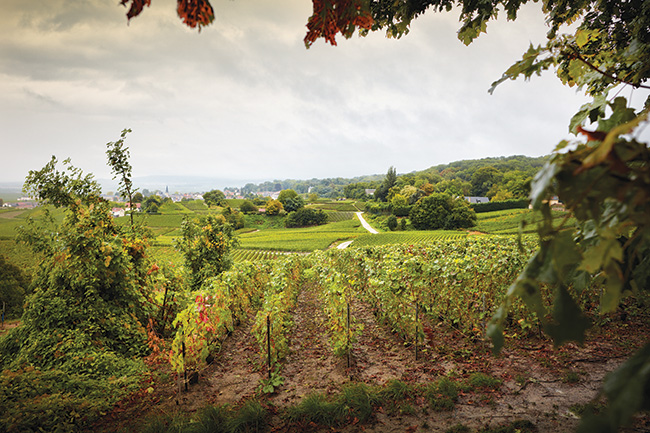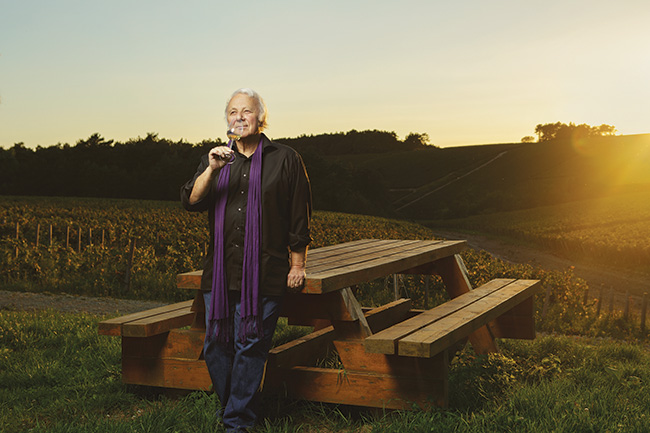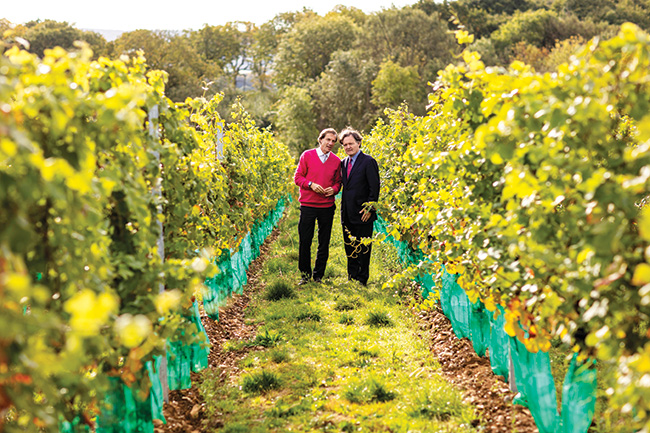Champagne Takes on Climate Change
As a warming planet impacts winemakers everywhere, some champagne makers are taking on climate change and blazing a new path in the process.
On a brilliant day in the Aube, Champagne’s most southerly growing region, neat rows of grapevines slope up to the horizon as far as the eye can see. It’s the first week of June and the vines are in full flower. From the look of it, around 100 days from now, the harvest will be bountiful – weather permitting. But those two simple words, always problematic for winemakers, have taken on a whole new urgency in the past 10 to 20 years. Last year at this time, growers in Champagne were still calculating the damage from a severe frost in early April, when temperatures plunged as low as -8°C (17°F) overnight, destroying around 30 per cent of the region’s harvest and up to 90 per cent for some growers. The Aube, whose warmer southern climate results in earlier budding, was hard hit. Then came the rains. June was unusually wet, but in July, when growers depend on warmth and sunshine to bring the fruit to maturity, days of storms and torrential showers caused the worst outbreak of mildew – deadly to grapes – in decades. In a few weeks, much of the fruit that remained was ravaged on the vine.
Thirty years ago, the frost would probably not have affected the crop at all, since the vines would still have lain dormant. But in the past 20 years, temperatures in this historically cool northern climate have risen 1.2°C, accelerating bud-burst and the harvest by an average of 18 days. Between 1977 and 1987, seven out of ten harvests were in October and the rest in late September, just as they have been for at least 120 years, as far back as records go. In 2020, the region recorded its earliest harvest in history, its sixth in the past 15 years to begin in August. To be a winemaker is, above all, to work with nature. And while you won’t find any climate deniers in Champagne, you will find vintners who are clinging to the old ways, those who are cautiously testing methods more in harmony with the earth, and a handful who are pushing sustainable agriculture forward and quietly revolutionising winemaking in the process. And the Aube is where it all began.

The interior of farm-to-table restaurant Le Garde Champêtre © Le Garde Champêtre
Biodynamics: Is This the Future?
Le Garde Champêtre, in the sleepy riverside village of Gyé-sur-Seine, is Champagne’s first (and only) true farm-to-table restaurant and auberge, opened in 2018 by Paris restaurateur Juan Sanchez and partners. The restaurant’s gastronomic menu is furnished largely by its four-acre garden, abutting an outdoor dining area. It didn’t take long for Le Garde to become the favourite haunt of winemakers and locals in the Aube and throughout Champagne, along with foodies from as far as Dijon and Paris. Its soaring dining room was the perfect place to talk about climate and Champagne with Jean-Sébastien Fleury and Raphaël Piconnet, biodynamic winemakers whose champagnes Sanchez champions here, as well as at his all-natural wine shop in Paris.
Jean-Sébastien, a third-generation winemaker in the nearby village of Courteron, in Aube’s Côte des Bar, works with his father, Jean-Pierre Fleury, the first grower-producer in Champagne to pioneer biodynamics, an integrative and complex farming method that considers every aspect of the environment, from insects to astronomy, in its practices. Fleury had converted to organic methods all the way back in 1970, and began cultivating biodynamically in 1989, completing the conversion of his entire estate in 1992. Champagne Fleury has since become a reference in Champagne and across France, as much for its expertise as for its outstanding wines, drawing students and young winemakers from all corners of the country to learn the principles and practices of biodynamics.

Jean-Sébastien Fleury tasting the wine © S Chaplis
Champagne-maker Raphaël Piconnet didn’t have to go far. Inspired by Fleury and determined to convert his family’s Domaine de Bichery, 3km away, he met with resistance. “In Champagne there’s a lot of economic pressure; if your parents are fully chemical they don’t want to hear about organic.” It’s a resistance characteristic of older winemakers set in their ways, but not so much the younger vintners – a generation increasingly under the pressure of nature’s growing instability, and faced with mounting evidence that working in harmony with nature is not only more satisfying but reflects positively in the wines.
Paradoxically, agree Raphaël and Jean-Sébastien, it isn’t so much the warming temperatures that are negatively affecting Champagne’s winemakers – at least for now – but it’s the unpredictability and extremity of the weather that comes with climate change: prolonged periods of rain or drought, early heat and late frosts, hail the size of marbles… all are hard to handle.
But here is the upside: warmer summers mean faster-growing grapes, so it’s no longer such a challenge to obtain the right amount of sugar for a balanced wine. Especially from the acidic Chardonnay grape – one of the three principal champagne grapes – a diverse, slow-ripening fruit that imparts champagne’s citrusy, flowery or mineral notes, depending on the terroir, and which growers have always struggled to keep on the vine long enough to reach sufficient ripeness. But even as yields are shrinking, the wines are improving. “We’re at the perfect time,” confirms Fleury. “Before, it was necessary to add quite a quantity of sugar to reach 11 or 12 degrees [alcohol] in Champagne; it was hard to get maturity at the right level. Our time is just perfect to make wine without too many additives like sugar – it is easy for us.”

Winemakers Jean-Sébastien Fleury and Raphaël Piconnet © J Ladonne
Slowly but Surely
Of the 33,000 hectares of vineyards in Champagne, fewer than 600 are certified organic and less than two per cent of winemakers have embraced biodynamic methods. Leclerc Briant in Épernay – in some ways the northern counterpart to Fleury – is another pioneer.
Bertrand Leclerc, descendent of a family heritage that dates back nearly 150 years, quit using newly-introduced chemicals in 1947, suspecting they were making him sick. His son, Pascal, continued working organically while experimenting with biodynamics in the 1990s. The results were so promising that by 2005, his entire 30-hectare vineyard was certified biodynamic. Although Pascal died in 2010, and the house mostly changed hands, it maintained a strict allegiance to biodynamic methods, engaging the expertise of Hervé Jestin, one of the most respected organic winemakers in the Champagne region. “Biodynamic is a word that’s too large… we don’t do the same as biodynamic producers in the south of France, even here, even at Fleury,” says Pierre Bettinger, a partner at Leclerc Briant. “But the common ground is that we put nature at the centre; we try to express nature.” What they also have in common is the desire to create not just good wines, but reach true excellence, and they happen to believe, as Bettinger says, “the best way is the biodynamic way”.
More and more people are seeing that organic and biodynamic wines, when done correctly and for the right reasons, are not what the word once conjured (and still does for some): “funky wines made by hippies that smell like the skin of a wild pig,” laughs Bettinger. The wines can be vibrant, harmonious, rich and bold, depending on the parcel of land, since all of Leclerc Briant’s wines come from a single vintage and express a specific terroir – still a relative rarity in a region renowned for blending grapes from different parcels and different years to achieve a house style.
“Some might view his practices as controversial, even bordering on the arcane,” says Peter Liem, an American wine critic and specialist on champagne, whose tome Champagne: The Essential Guide to the Wines, Producers, and Terroirs of the Iconic Region is an authoritative sourcebook, “yet the results speak for themselves, being not only of a consistently high quality but also of an expressly individual character.”

The pioneering vineyards of Leclerc Briant © S Chapuis
Heading North
But it’s not just the smaller houses taking the measure of climate change and opting for sustainability. Louis Roederer began experimenting with biodynamic methods in 2000, using parallel plots – some biodynamic others not – in order to compare. The results are perhaps best summed up by the fact that some of the “biggest tasters” were able to distinguish which juices were produced biodynamically, and that the house uses the fruits of these plots in their vintage wines, even in Cristal, their premium champagne, starting at around $300 a bottle. Moët et Chandon has also been quietly testing the waters, and there is no doubt, according to industry rumours, that other big names have been quietly weighing the benefits too.
Still others are experimenting in cooler climates, as winemaking inevitably heads farther north. Taittinger, in partnership with English firm Hatch Mansfield Ltd, founded Domaine Evremond, in Kent, England, where the chalk soil is part of the same vein that runs under the Champagne region, and where winemakers have had fabulous success making outstanding sparkling wines.
Patrick McGrath, a partner in Evremond, wouldn’t say climate was the first catalyst for the venture, but he said: “Let’s just say I would never have had the conversation with my friend Pierre-Emmanuel Taittinger if the climate were getting colder.” Although Taittinger will be the first French house to create a sparkling wine from start to finish on English soil (the project began in 2015 and the first wines will be sold in 2024), Pommery has since moved in. When I asked McGrath if he expects more French producers to arrive in the UK, he said he’d be very surprised if they didn’t.

Jean-Pierre Fleury is a pioneer in the world of biodynamics © Champagne Fleury
The Proof is in the Bottle
But what is this ineffable quality that winemakers are convinced biodynamics can express? Pierre Bettinger is quick to point out that while he won’t say Leclerc Briant’s wines will be better than nonbiodynamic wines, they will be better for you. With lower sugar, sulfites and free of the chemicals used in conventional growing, the wines will do less harm to your body. Yes, the goal is to have more complexity, a better expression of the terroir, and as great a wine as possible. But perhaps the ultimate goal is the least tangible one – a certain “soul” in the wine, a word both Bettinger and Fleury use to describe their inspiration. “In my opinion,” says Bettinger, “there is something more, a touch, an emotion in the wine that you can’t always explain. And I think the biodynamic processes bring that. Because that comes from nature expressing itself through the wine.”
Jean-Sébastien Fleury agrees: “You try to open your ear, not only to hear, but all your feelings, so you can listen to and understand the wine, which is full of joy, full of patience… that’s something I give all my knowledge to, my love. The emotion is going into the bottle and to the people who are drinking the wine.” There’s no doubt in these winemakers’ minds that nature is increasingly having its way with them, not the other way around. All the effects climate change will have on wine are as yet unknown – but it’s clear that working in harmony with nature benefits everyone.
Lead photo credit : Patrick McGrath and Pierre-Emmanuel Taittinger at Domaine Evremond in Kent © Patrick McGrath
Share to: Facebook Twitter LinkedIn Email
More in biodynamic wine, Champagne region, Chardonnay, French champagne, French wine, French winemaking, history of Champagne
Leave a reply
Your email address will not be published. Required fields are marked *





